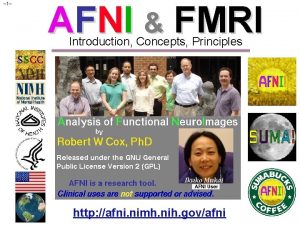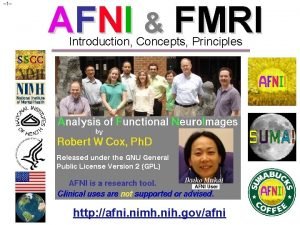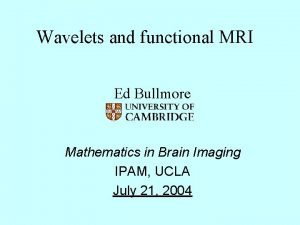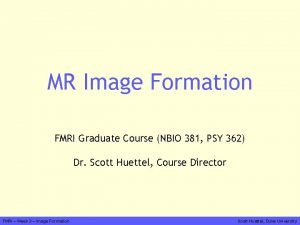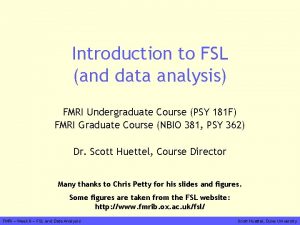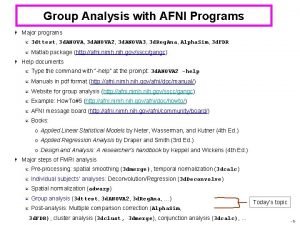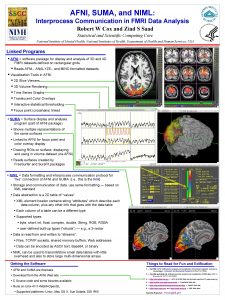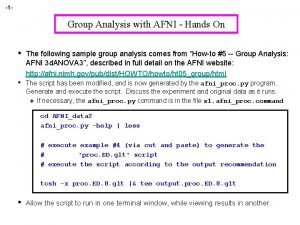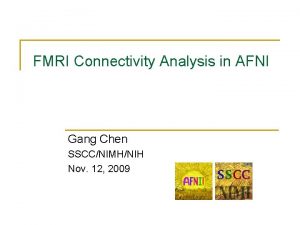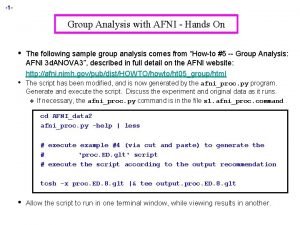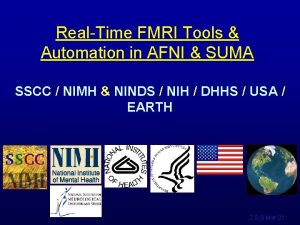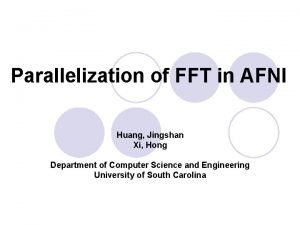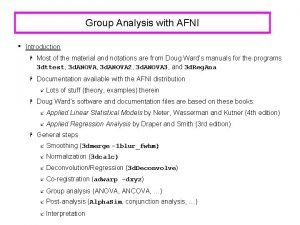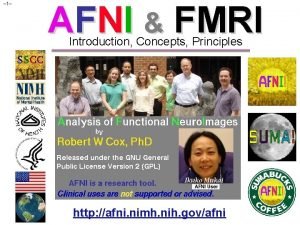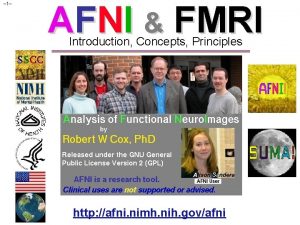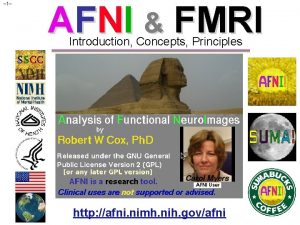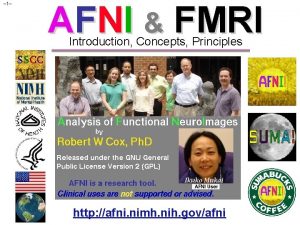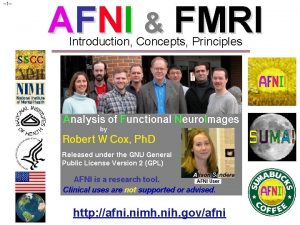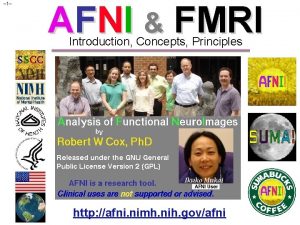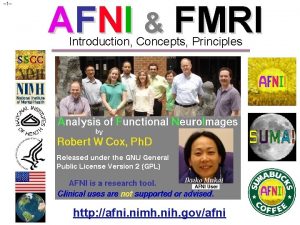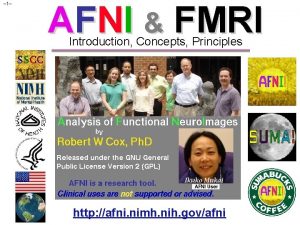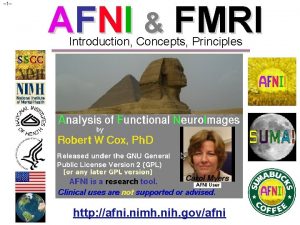1 AFNI FMRI Introduction Concepts Principles http afni












- Slides: 12

– 1– AFNI & FMRI Introduction, Concepts, Principles http: //afni. nimh. nih. gov/afni

– 2– AFNI = Analysis of Functional Neuro. Images • Developed to provide an environment for FMRI data analyses And a platform for development of new software • AFNI refers to both the program of that name and the entire package of external programs and plugins (more than 100) • Important principles in the development of AFNI: H Allow user to stay close to the data and view it in many different ways H Give users the power to assemble pieces in different ways to make customized analyses o “With great power comes great responsibility” — to understand the analyses and the tools H “Provide mechanism, not policy” H Allow other programmers to add features that can interact with the rest of the package H

– 26– Fundamental AFNI Concepts • Basic unit of data in AFNI is the dataset H A collection of 1 or more 3 D arrays of numbers Each entry in the array is in a particular spatial location in a 3 D grid (a voxel = 3 D pixel) o Image datasets: each array holds a collection of slices from the scanner å Each number is the signal intensity for that particular voxel o Derived datasets: each number is computed from other dataset(s) å e. g. , each voxel value is a t-statistic reporting “activation” significance from an FMRI time series dataset, for that voxel o H Each 3 D array in a dataset is called a sub-brick o There is one number in each voxel in each sub-brick 3 x 3 x 3 Dataset With 4 Sub-bricks

– 28– Dataset Contents: Header • Besides the voxel numerical values, a dataset also contains auxiliary information, including (some of which is optional): H xyz dimensions of each voxel (in mm) H Orientation of dataset axes; for example, x-axis=R-L, y-axis=A-P, z-axis=I-S axial slices (we call this orientation “RAI”) H Location of dataset in scanner coordinates o o H Time between sub-bricks, for 3 D+time datasets o H Needed to overlay one dataset onto another Very important to get right in FMRI, since we deal with many datasets Such datasets are the basic unit of FMRI data (one per imaging run) Statistical parameters associated with each sub-brick o o e. g. , a t-statistic sub-brick has degrees-of-freedom parameter stored e. g. , an F-statistic sub-brick has 2 DOF parameters stored

– 29– AFNI Dataset Files - 1 • AFNI formatted datasets are stored in 2 files The. HEAD file holds all the auxiliary information H The. BRIK file holds all the numbers in all the sub-bricks Datasets can be in one of 3 coordinate systems (AKA views) H Original data or +orig view: from the scanner H AC-PC aligned or +acpc view: H • o H Dataset rotated/shifted so that the anterior commissure and posterior commissure are horizontal (y-axis), the AC is at (x, y, z)=(0, 0, 0), and the hemispheric fissure is vertical (z-axis) Talairach or +tlrc view: Dataset has also been rescaled to conform to the Talairach. Tournoux atlas dimensions (R-L=136 mm; A-P=172 mm; I-S=116 mm) o AKA Talairach or Stererotaxic coordinates o Not quite the same as MNI coordinates, but very close o

– 30– AFNI Dataset Files - 2 • AFNI dataset filenames consist of 3 parts The user-selected prefix (almost anything) H The view (one of +orig, +acpc, or +tlrc) H The suffix (one of. HEAD or. BRIK) H Example: Bill. Gates+tlrc. HEAD and Bill. Gates+tlrc. BRIK H When creating a dataset with an AFNI program, you supply the prefix; the program supplies the rest AFNI programs can read datasets stored in several formats H ANALYZE (. hdr/. img file pairs); i. e. , from SPM, FSL H MINC-1 (. mnc); i. e. , from mnitools H CTF (. mri, . svl) MEG analysis volumes H ASCII text (. 1 D) — numbers arranged into columns H Have conversion programs to write out MINC-1, ANALYZE, ASCII, and NIf. TI-1. 1 files from AFNI datasets, if desired H •

– 42– Other Parts of AFNI • Batch mode programs Are run by typing commands directly to computer, or by putting commands into a text file (script) and later executing them Good points about batch mode H Can process new datasets exactly the same as old ones H Can link together a sequence of programs to make a customized analysis (a personalized pipeline) H Some analyses take a long time (are not interactive) Bad points about batch mode H Learning curve is “all at once” rather than gradual H If you are, like, under age 35, you may not know how to, like, type commands into a computer to make it do things H • • o But we don’t make you use punched cards or paper tape (yet)

– 43– AFNI Batch Programs • Many many important capabilities in AFNI are only available in batch programs H A few examples (of more than 100, from trivial to complex) • 3 d. Deconvolve + 3 d. REMLfit = multiple linear regression on 3 D+time datasets; fits each voxel’s time series to activation model, tests these fits for significance (3 d. NLfim = nonlinear fitting) • 3 dvolreg = 3 D+time dataset registration, to correct for small subject head movements, and for inter-day head positioning • 3 d. ANOVA + 3 d. LME = 1 -, 2 -, 3 -, and 4 - way ANOVA/LME layouts: combining & contrasting datasets in Talairach space • 3 dcalc = general purpose voxel-wise calculator (very useful) • 3 dclust = find clusters of activated voxels (now in GUI, too) • 3 dresample = re-orient and/or re-size dataset voxel grid • 3 d. Skull. Strip = remove “skull” from anatomical dataset • 3 d. DWIto. DT = compute diffusion tensor from DWI (nonlinearly)

– 44– AFNI Plugins • A plugin is an extension to AFNI that attaches itself to the interactive AFNI GUI H Not the same as a batch program (which runs by itself) H Offers a relatively easy way for a C programmer to add certain types of interactive functionality to AFNI • Draw Dataset = ROI drawing (draws numbers into voxels) • Render [new] = Volume renderer • Dataset#N = Lets you plot multiple 3 D+time datasets as overlays in an AFNI graph viewer (e. g. , fitted models over data) • Histogram = Plots a histogram of a dataset or piece of one • RT Options = Controls the realtime image acquisition capabilities of AFNI (e. g. , graphing, registration) • Plugout: a separate program that sends commands to AFNI to drive the display (sample scripts given later)

– 45– SUMA, et alii • SUMA is the AFNI surface mapper H For displaying surface models of cortex o Surfaces from Free. Surfer (MGH) or Caret (Wash U) or Brain. Voyager (Brain Innovation) Can display functional activations mapped from 3 D volumes to the cortical surface H Can draw ROIs directly on the cortical surface H o vs. AFNI: ROIs are drawn into the 3 D volume • SUMA is a separate program from AFNI, but can “talk” with AFNI (like a plugout) so that volume & surface viewing are linked H Click in AFNI or SUMA to change focus point, and the other program jumps to that location at the same time H Functional (color) overlay in AFNI can be sent to SUMA for simultaneous display • And much more — stayed tuned for the SUMA talks to come!

– 54– Other Educational Presentations • How to get images into AFNI or NIf. TI format (program to 3 d) • Detailed hands-on with using AFNI for data viewing (fun) • Signal modeling & analysis: theory & hands-on (3 d. Deconvolve) • Image registration (3 dvolreg, et al. ) • Volume rendering hands-on (fun level=high) • ROI drawing hands-on (fun level=extreme) • Transformation to Talairach hands-on (fun level=low) • Group analysis: theory and hands-on (3 d. ANOVAx and beyond ) • Experiment design • FMRI analysis from start to end (the “soup to nuts” hands-on) • SUMA hands-on (fun level=pretty OK) • Surface-based analysis • AFNI “Jazzercise” (practice sessions & directed exercises)

– 55– Ongoing AFNI SUMA Projects • Complex ANOVA-like models for group analyses [3 d. LME. R] H Unbalanced designs, missing data, continuous covariates, multi-nested designs, …. (the list and the project don’t really end) • Changing 3 d. Deconvolve to incorporate physiological noise cancellation, and correction for EPI time series autocorrelation This one [3 d. REMLfit], and … is done! • More surface-based analysis tools H Especially for inter-subject (group) analyses • Better EPI-anatomical registration tools [3 d. Allineate] And nonlinear 3 D inter-subject registration • Integrating some external diffusion tensor (DTI) tools with AFNI (e. g. , DTIquery ) • Integrating more atlas datasets (animal and human) into AFNI • Semi-linear global deconvolution analysis H
